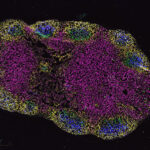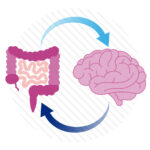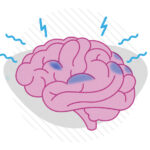From our labs and clinics: 10 research advances in 2021

Pediatric medicine at Boston Children’s Hospital rests on a strong base of discovery science. But it can take decades for bench discoveries to be validated and replicated in humans and for treatments to be proven safe. When lab discoveries advance on the road to clinical application, it’s cause to celebrate. Here are 10 research success stories this year from across the hospital.
1. A promising new anti-seizure drug tailored to newborns
There are no completely effective drugs for seizures in newborns, in part because they differ fundamentally from seizures in older children and adults. Long-time research led by Janet Soul, MD, may soon yield a treatment tailored to newborns’ uniquely excitable brains. Bumetanide, a repurposed drug, has been used safely in infants as a diuretic. It’s shown good results in a pilot clinical trial, and a larger, more definitive trial is in the offing. To help advance the field, Soul and her co-authors offer recommendations for overcoming the logistical challenge of drug testing in newborns with seizures — a hurdle that has held new treatments back.
2. The Pediatric Cancer Dependency Map
Unlike adult cancers, childhood cancers carry few genetic mutations, and the mutations they do have typically cannot be targeted with drugs. As a result, only about a quarter of pediatric cancers have targeted treatments. Kimberly Stegmaier, MD, took a different approach to cancer genetics, asking what genes pediatric cancer cells need for daily survival. That led to the creation of a “dependency” map for more than a dozen tough-to-treat child cancers. Published in March, it offers a new universe of potential targets — some of which have known inhibitor drugs. Interestingly, a similar map created for adult cancers shows a different pattern of dependencies.
3. Noninvasive biomarkers, found in urine, help track DIPG, moyamoya
Diffuse intrinsic pontine glioma (DIPG), an aggressive, deadly brainstem tumor in children, is difficult to measure and too dangerous to biopsy. Researchers Julie Sesen, PhD, in Vascular Biology, and Edward Smith, MD, in Neurosurgery reported in June that levels of a specific protein in a patient’s urine offer reliable information on the tumor’s size and responsiveness to treatment. Separately, Smith, Sesen, and Darren Orbach, MD, reported a panel of predictive urine biomarkers for moyamoya disease, a rare vascular condition in the brain that can lead to stroke. The biomarkers could reduce the need for lengthy brain imaging studies and help determine the optimal timing for surgery.
4. An oral medication improves motor function in spinal muscular atrophy
In spinal muscular atrophy (SMA), dysfunctional motor neurons in the spinal cord and brainstem cause weakened muscles. Over the past decade, a series of disease-modifying treatments have emerged for SMA, with Boston Children’s Hospital playing a leading role. The first of these, Spinraza, requires injections into the spinal canal, but the newest treatment, risdiplam, can be taken orally. In July, a clinical trial led by Basil Darras, MD, showed improved motor function with risdiplam in babies with SMA.
5. A new ring for pediatric heart valve surgery
Cardiac surgeons use annuloplasty rings to secure heart valve repairs in adults. But existing rings can’t be used in children because their hearts are still growing. Heart Center surgeon Eric Feins, MD, and his colleagues created an expandable design that grows with the child. The ring’s inner biocompatible material can be fine-tuned to degrade at different rates so that the sleeve elongates at the ideal rate for the child’s age. In partnership with Boston Children’s Drug, Device, Diagnostics Accelerator, the Heart Center is moving the ring toward clinical testing. It’s the latest in a series of innovations to treat valvular disease in children.
6. Debunking diet dogma: Low-carb diet outperforms low-fat diet
For most of the past 50 years, experts have promoted low-fat diets. Now, one of the most rigorous clinical trials to date, published in September, may change that thinking. Led by David Ludwig, MD, and Cara Ebbeling-Zabilansky, PhD, the trial compared low-fat and low-carbohydrate diets head to head. This entailed providing more than 100,000 meals tailored to participants’ caloric needs. Participants assigned to low-carb diets had better cardiovascular and metabolic profiles, even though these diets were higher in saturated fat. Ludwig and Ebbeling propose a “carbohydrate-insulin model” that points to refined carbohydrates — not just excess calorie consumption — as a factor in obesity.
7. Exercise, sleep, and the preteen brain ‘connectome’
In early adolescence, brain circuits mature rapidly, especially circuits involved in higher-level thought processes. Unfortunately, many kids get inadequate sleep and too little exercise during these years. In two separate studies, Caterina Stamoulis, PhD, analyzed brain imaging data from more than 5,000 preteens, using mathematical techniques to examine multiple brain networks that play key roles in cognitive function. Crunching these data against general health information provided by parents, Stamoulis found that the more sleep and physical activity the children got, the more robust their brain connections.
8. New hope for patients with unrelated bone marrow donors
December saw great news for people seeking unrelated donors for a bone marrow transplant. The Food and Drug Administration announced its approval of abatacept, a repurposed arthritis drug, for the prevention of graft-versus-host disease in patients as young as 2. The availability of abatacept opens up many more donor match possibilities, especially for people of color. Leslie S. Kean, MD, PhD, who directs the Stem Cell Transplant Center at Dana-Farber/Boston Children’s Cancer and Blood Disorders Center, led the laboratory and clinical research behind this historic approval.
9. Creating best practices for personalized treatments
There’s been an explosion of interest in creating fast-track custom drugs for patients with ultra-rare genetic disorders. Most of these are antisense oligonucleotides (ASOs), drugs that mirror the patient’s mutation and silence its effects. Timothy Yu, MD, PhD, who pioneered the first such treatment for a single child, is now leading the N of 1 collaborative with support from the Chan Zuckerberg Initiative. The international group is working to ensure that further personalized treatments advance in an ethical, safe, and sustainable way.
10. Advances in COVID-19 science
As COVID-19 waxed, waned, morphed, and waxed again this year, Boston Children’s made many research advances. They include new insights on multisystem inflammatory syndrome in children (MIS-C), new protein-based vaccines, insights on the immune responses to SARS-CoV-2, structural insights on new variants, and more — enough to merit its own top 10 list. We hope all the COVID-19 news in 2022 is good news.
Explore basic/translational and clinical research at Boston Children’s Hospital.
Related Posts :
-

Creating the next generation of mRNA vaccines
During the COVID-19 pandemic, mRNA vaccines came to the rescue, developed in record time and saving lives worldwide. Researchers in ...
-

Boosting vaccines for the elderly with ‘hyperactivators’
As we age our immune systems start to flag, leaving us more susceptible to cancer and infections — and less responsive ...
-

The gut-brain connection: A new approach to OCD and tic disorders?
It’s natural for young children to use routines to help them navigate the world and for older children and ...
-

Can we prevent seizures in Sturge-Weber syndrome?
Port wine stains — capillary malformations on the skin — are the most visible manifestation of Sturge-Weber syndrome. However, up to 60 percent ...





